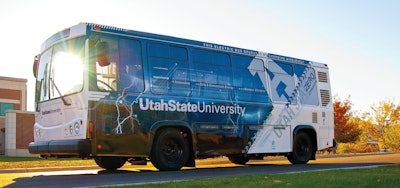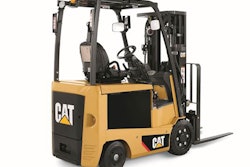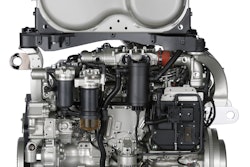
Battery technology limitations continue to be the greatest challenge facing the electric vehicle market, specifically in power density. For vehicles such as city buses, very large batteries (sometimes even multiple batteries) are required to provide the power necessary to run the buses for several hours, adding weight and operating costs. “The problem with [all-electric] buses is that they are extremely expensive to build because batteries are expensive,” says Curt Roberts, Associate Vice President for Commercialization at Utah State University. “The bus actually has to have its chassis reinforced and extra engineering done just to carry the weight of the battery, and by the time that’s done, you have a bus that costs two and half times what a regular diesel bus costs.”
However, researchers at Utah State University (USU), Logan, UT, have found a way to reduce battery size—and thus the cost of electric buses—by developing a wireless power transfer (WPT) system. A disk buried beneath the ground at a central station, or various stops along the route, transmits electricity to a secondary disk placed on the undercarriage of the bus which delivers the electricity to the bus battery. Each time the bus stops over a WPT disk the battery is recharged. By doing this several times throughout the day, a much smaller battery can be used. “Since we only need enough energy to travel down the route once, theoretically we only need [the] battery energy to last one route, then it’ll come back and recharge,” says Hunter Wu, Chief Scientist on Wireless Power Transfer Technology at USU. “If it’s a 12-hour operation, we’re charging 48 times a day, so theoretically, the battery can get 48 times smaller compared to typical batteries in heavy-duty vehicles.”
In November 2012, the WPT system was unveiled using a working demonstration bus on the USU Innovation Campus (visit oemoffhighway.com/10837382 to learn more). “We had always felt that the largest opportunities in wireless power for vehicles were not in cars…the best opportunities were larger, heavier vehicles that would run repeated routes—places where they would be able to constantly return to a location where they could pick up a charge,” says Roberts.
How it works
The primary underground WPT disk in USU’s system contains wireless power electronics that convert direct current (DC) voltage received from a nearby electrical grid to high frequency alternating current (AC). As the AC voltage passes through a transmitting coil it is turned into a high frequency magnetic field. This magnetic field “jumps” the 8- to 10-inch air gap between the primary WPT disk and the secondary disk on the vehicle’s undercarriage where receivers then convert the magnetic field back to a DC voltage output that charges the bus’ battery.
As soon as a vehicle equipped with the WPT system aligns over the top of the primary WPT disk power transfer to the secondary disk begins. The system can either be manually activated by the driver, who simply pushes a button to activate the battery recharging process, or it can be automated. “There’s what you might think of as a ‘digital handshake’ where the two [disks] see each other, recognize there are safe operating conditions to transfer power, and the transfer begins,” says Roberts. “The operator will have confirmation inside of the bus if power is transferring and at what rate it’s transferring.” An 8-inch misalignment was built into the system so that even if the operator misses driving over the primary disk by 8 inches—to the left, right, front or back—the system will still transfer power at full efficiency. “That was also a critical operating performance metric for us to achieve,” says Roberts. “If transferring power required a vehicle operator to be so precise every time for it to work, you could imagine a lot of conditions in which you wouldn’t get it right and then you would end up with the possibility that the bus would run out of power sometime during the course of the time period in which it’s supposed to operate.”
Though transmitting electricity through the air is not a new concept, Roberts says researchers have spent years trying to apply the technology to vehicular applications. The biggest challenge has been finding a way to focus electricity so that it does not spread out through the air but is instead focused in a specific direction so it can be picked up by a charging system. “That’s one of the things we think we’ve solved,” says Roberts. The WPT system developed by USU is able to transfer electricity at an efficiency rate of 90%, which Wu says is comparable with conductive (plug-in) charging systems.
The first prototype is a 25 kilowatt (kW) inductive charging system which allows operators to drive for 10 minutes, return to the central charging station and charge for five minutes. When designing the final system, Wu says varying circumstances such as rush hour traffic were taken into account that would enable the vehicle to travel for longer periods before charging. “Our typical battery size [lets] our bus run for at least an hour during its normal time,” says Wu.
For the first commercial demonstration bus using the WPT system, the power level will be doubled to 50 kW, enabling it to run a full route before recharging. This bus will go into operation at the University of Utah campus in the first quarter of 2013. “The more power you can transfer, the smaller the battery can be or the longer the bus range can be, and therefore the more types of routes [the bus] can be operated on,” says Roberts.
Why go wireless?
Vehicles running on the WPT system are 100% green, says Wu, because there are absolutely no emissions released into the atmosphere. Several states, such as California, have begun prohibiting diesel buses and implementing laws which say all new buses must use clean energy solutions. The WPT system can help transit operators meet this requirement in an economical manner because the cost of running a vehicle on electricity is significantly reduced compared to diesel and compressed natural gas (CNG). (See graph, pg. xx for a cost comparison.)
As with any new vehicle, there is an initial investment—the price of a WPT bus may be a little more than a diesel one, and there will be costs associated with burying the primary WPT disk under the ground and hooking it up to the electric grid—but the long-term cost savings will outweigh the initial investment, says Wu. “We’ve shown that over a seven-year cycle we can easily recoup the cost of the initial investment into the wireless power infrastructure,” he says, “because electricity is so much cheaper compared to diesel. [Electricity is] about one sixth the price per mile on these buses.” And unlike fuel prices, the cost of electricity doesn’t fluctuate as often since its cost is typically only adjusted according to inflation. “That’s something [transit authorities] really like because it helps them manage in terms of what the bus is going to cost next year, how to maintain it and how to run it,” says Wu.
Maintenance costs over the lifespan of a WPT vehicle tend to be lower as well. Wesley Smith, CEO of WAVE (Wireless Advanced Vehicle Electrification)—a spin-out company from USU which licenses the WPT technology to find commercial applications for it—says because the system uses solid-state technology, there are no moving parts and thus fewer chances for failure to occur. “When you have moving parts, you introduce more points of failure into the system,” he says. The solid-state technology consists of inverters, which are made up of power electronic components on integrated circuit boards, in the primary and secondary WPT disks. “Since these systems are entirely insulated and isolated from each other, as well as other moving parts, once you integrate the system into an application you avoid all of the weaknesses associated with a mechanical system,” says Smith.
When electricity is passed through the air, there are often concerns about electromagnetic interference (EMI). However, the focused transmission of electricity between the WPT disks ensures there will be no interference with pacemakers or cell phone signals in the nearby area. Currently the system meets the International Standard for Electromagnetic exposure to humans, which is one of the strictest standards in the world. “You can literally stick your hand in between those pads when the power’s flowing through them and it won’t harm you,” says Smith.
Increasing power
Increasing the power level is the next big step for Wu and his colleagues. “Right now to wait for five minutes while you drive for 15 is really quite inconvenient for most of the mass transit authorities,” says Wu. “What they’d really like to do is drive the bus for an hour and charge for five minutes.” The WPT development team has been advancing the power level at an aggressive pace, doubling it every six months. If able to keep at their current pace, Wu believes the team will reach a power level in the megawatts within the next two to three years, which will be important when applying the technology to heavier duty applications, such as mining.
WAVE’s Smith believes the WPT system would be transformational for off-highway applications because they often operate on 12- to 24-hour duty cycles. “If an off-road [operation] wants to go to a zero-emission solution, it really only has two options,” says Smith; vehicles can either be run on an overhead wire known as a Catenary, causing them to always be plugged into the electric grid and thus limited in mobility, or they can be taken offline to be recharged, which for 24/7 operations means having fleets that are twice the size as normal to ensure continuous productivity.
Underground mining, for example, is an area WAVE has been exploring as a potential application. Overhead charging is not feasible for underground mining because of the potential for sparking, which would be dangerous to those working in and around the mine. WPT disks placed on the mine ceiling or the mine floor could be used to charge ultracapacitors or battery packs on the mining vehicles as they move back and forth between the corridors and the main truck line.
Implementing the WPT system on large surface mining haul trucks is also being investigated. For this application, Wu says dynamic charging rather than stationary will be the preferred method. Hundreds of the WPT disks placed along the roadway, essentially electrifying it, will enable the haul trucks to continuously charge as they drive along their routes. “There’ll be quite a bit of investment initially, but the long-term cost reduction in terms of savings in diesel is very significant,” says Wu. Continuously charging the trucks as they move along the roadway also eliminates any downtime associated with refueling or recharging as is common with traditional vehicle types.
Smith says there will be challenges associated with the increased power transfer necessary for these larger vehicles. “Most of them have to do with heat management issues because those high power transfer components generate a lot of heat.” However, he also notes these challenges are common to all high power systems, whether they use inductive or conductive charging, and overcoming these challenges is feasible.
One of the last applications that will be investigated for potential implementation is the Class 8 truck market. Wu says the long distances these vehicles travel makes it difficult to charge them during rest periods. Dynamic charging would be a better option, but because interstates in North America are so long, the investment costs would be considerable. “[That market] we’re going to tackle once the technology comes to a point where the cost comes down dramatically, we fully understand the infrastructure and we can fully scale this [technology] to the multimillions,” says Wu.
Along with increasing the power level, Smith says eventually the team will want to shrink the size of the WPT disks, especially the secondary one, to reduce the risk of wear and tear due to the secondary disk being located on the undercarriage of a vehicle. Increasing the amount of misalignment between the primary and secondary disks will also be an area of future development.
Creating partnerships with OEMs in the various industries which would most benefit from using the WPT system is high on the list of priorities for WAVE. “Our view is that we want to stay focused on our core competency, which is the development of the application,” says Smith. “We don’t want to be in the business [of manufacturing]. There are other groups that do that better, and we want to very quickly be partnering with OEMs.”




















